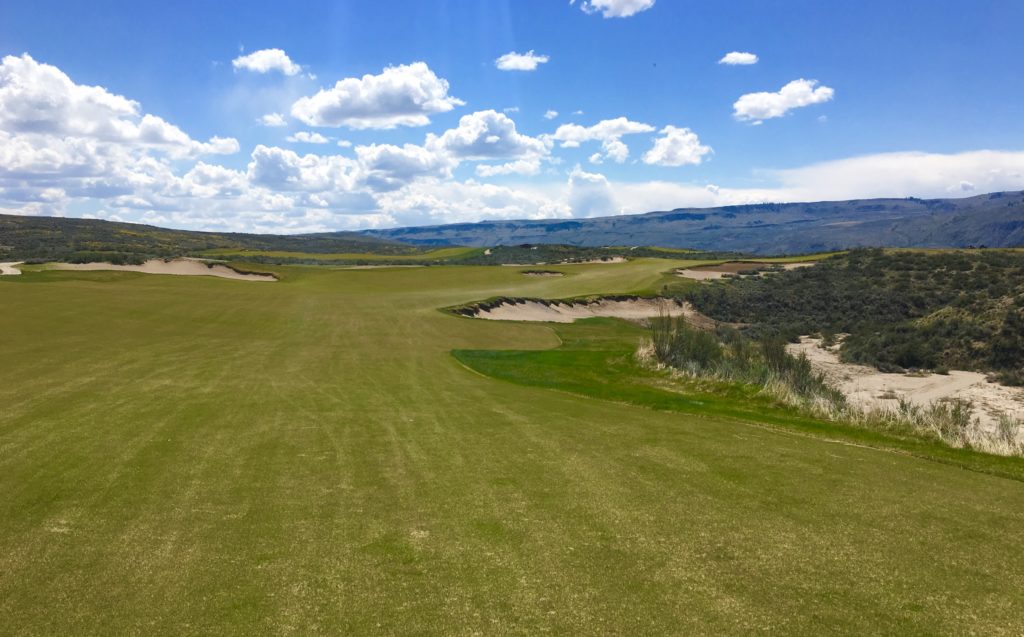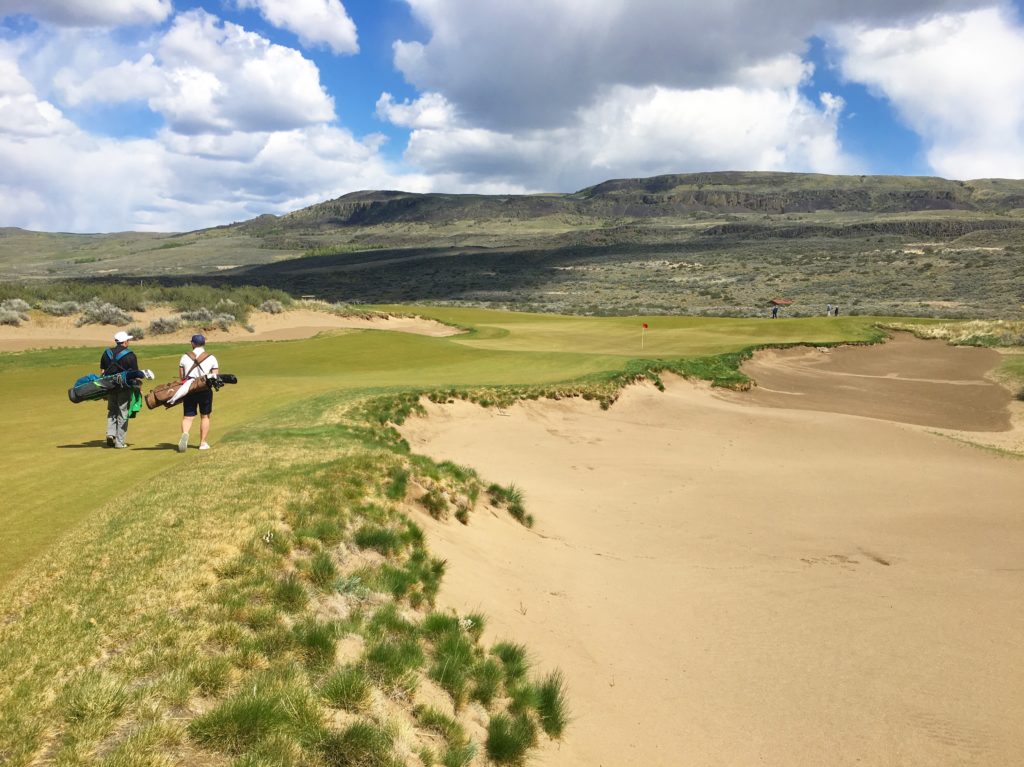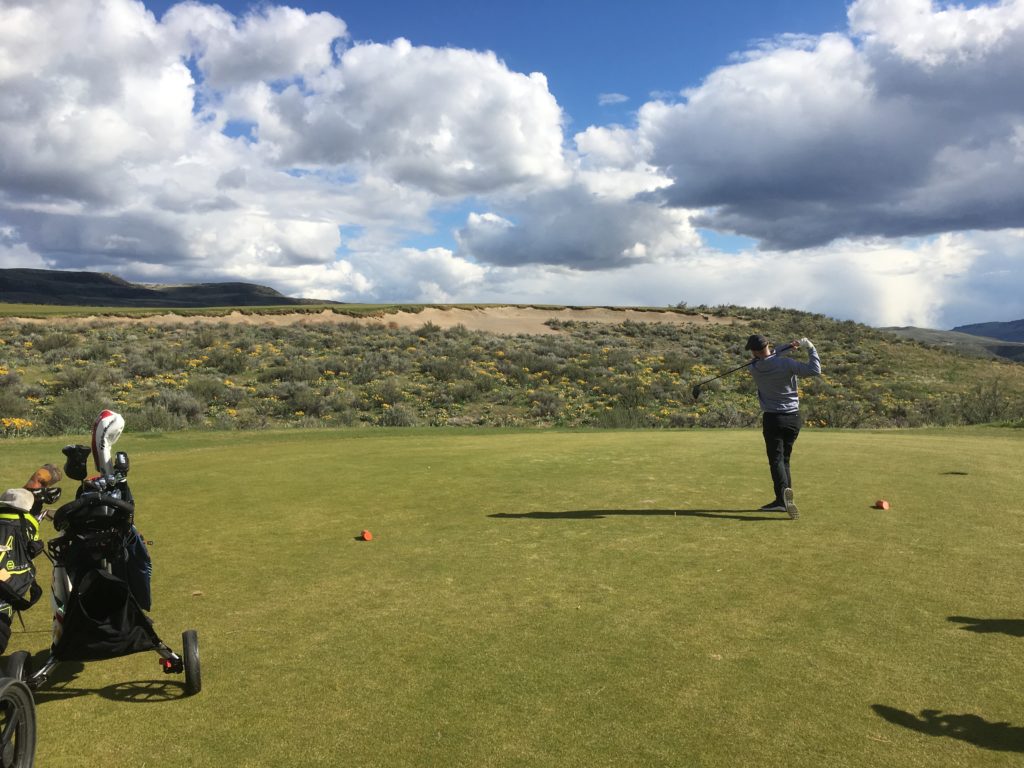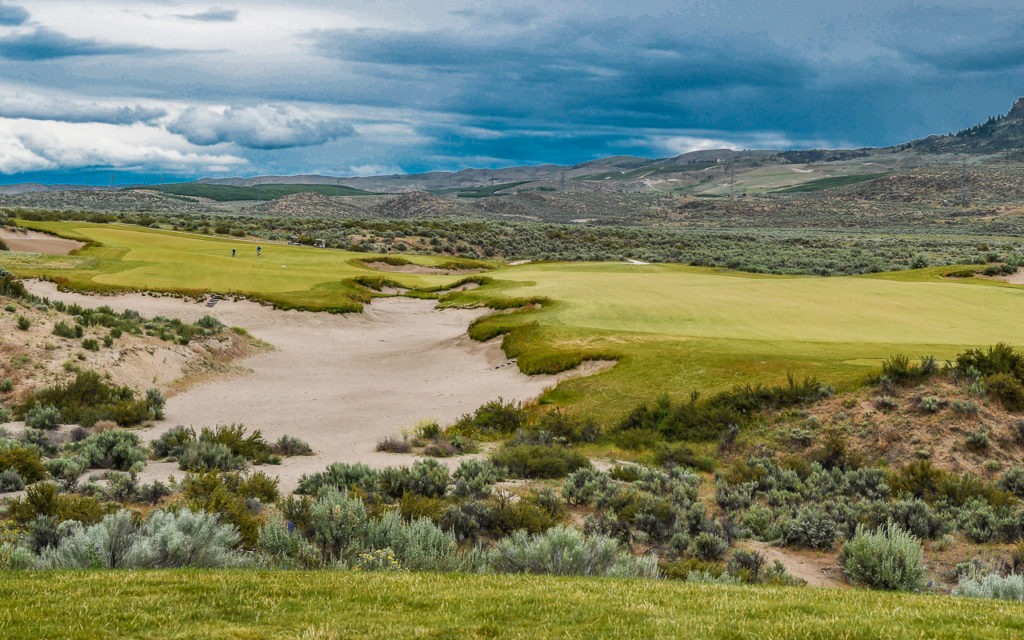Gamble Sands is a vacation from the diabolical “resistance to scoring” tests that have turned some links layouts into pursuits of pain instead of par.
The typical reaction from golfers:
“Fun!”
“I broke 100 for the first time!”
“Can I play again?”
Brian Benitz calls the Brewster, Washington, course “adventure golf” and one of “the ultimate buddies trips.”
“Once you get here,” the course’s Director of Operations said of the hottest new links golf destination in the country, “you turn off your car and all you do is play golf and have fun.”
But he also hears this a lot: “Why did you guys build a golf course here?”
The reason is simple – the Gebbers family is an agricultural giant (No. 1 in the world in cherry production, No. 2 in apples) that owns thousands of acres of land, and it wanted to diversify some of its property along the Columbia River.
The result is simply marvelous.

The wild and radical par-5 7th hole at Gamble Sands. 
The par-3 10th hole 
The tee shot at the par-5 3rd is semi-blind and plays over an elevated ridge line
While Gamble Sands, which opened in 2014, has more than enough challenges to make a top player pay attention, it’s extra friendly to the average golfer. No rough. No water hazards. Minimal forced carries. No tabletop greens that reject a well-struck shot – instead, the greens are like bowls that seem to welcome shots as opposed to reject them.
“It’s not an easy golf course; it’s just not unfair,” Benitz said. “Everybody has some sort of success or fun out here that they can take with them.”
The first thing to know about Gamble Sands is the fescue, which Benitz calls “pristine.” It’s cut tight and flows from tee to green.
“I will put our fescue turf against any other course that allows you to take carts,” he said. “If you keep the ball in front of you, your feet will leave turf only twice the whole round.”
That makes it a course you want to walk, if possible, especially when you’ve never played it before. It’s just more fun to see it that way.
It also makes the putter a great club choice, even from 100 yards away. Benitz said he goes so far as to use a putter off the tee on the 142-yard, par-3 fourth hole, and “I’ve made plenty of 3-putt pars to the dismay of my playing partners who may be fighting for a par or worse after hitting an iron off the tee.”
The green on another par-3, No. 16, is so big, it’s possible to have a putt that’s nearly 100 yards long. Yes, that’s 100 yards, not feet – Gamble Sands is built on 600 acres, so big greens are the norm.
Another notable feature of the 16th is the back of the green, which forms a huge backstop. Again, that’s not unusual. The average player will get accustomed to the joy of watching a poorly struck shot bound back into play.
Benitz continues “On the first tee we always tell players to wait until their ball stops moving to decide if it’s good or bad because you may be able to count to 10 before it comes to a final stop. Only then can you determine if it was good or bad shot.”
The fun begins right away on the second hole, a drivable par-4 that the course’s architect, David McKlay Kidd, has called his “favorite hole ever.”
Kidd was recruited for the project because he had become famous (some say infamous) for designing the original course at Bandon Dunes. After his initial success at Bandon Dunes, he became notorious for designing brutally tough layouts like Tetherow, TPC Stonebrae and the Castle Course at St. Andrews. But he had seen the terror of his ways and decided that, this time, he was going to build a course that’s more forgiving and fun.
Benitz said the other hole that golfers mention most often is No. 14, a split-fairway par-4 that is just, as he put it, “really cool.” It’s a typical links course that goes out from the clubhouse and doesn’t return until the 18th hole.

Those are the sorts of features that draw people to links golf. It’s a pleasant change from most U.S. courses, and Gamble Sands has all those memorable characteristics.
“You’re asked to hit shots that you can’t hit at home,” Benitz said. “You have to hit shots that you can’t hit at home.”
It’s so memorable, in fact, that it already has shot up the national rankings. In it’s most recent rankings, Golf Digest has it at No. 35 among the more than 10,000 public courses in the U.S., and Golfweek rated it the 17th-best resort course in America.
It made headlines locally two years ago when it was named the Top Public Golf Course in the state by Cascade Golfer Magazine, knocking Chambers Bay down to No. 2.
Gamble Sands is a four-hour drive from Seattle – just take Highway 2 to Wenatchee and then go north on Highway 97 along the Columbia River.
At least you don’t have to worry much about rain ruining your trip. The area gets only 10 inches of precipitation a year, just a little more than Phoenix. Like the Arizona desert, summertime temperatures can scoot over 100, but it’s a dry heat. Unlike the Arizona desert, it cools off at night.
Even if you do need an umbrella, at least your feet should stay pretty dry. Because the course is built entirely on sand, it drains especially well.
Staying at the course is part of the fun, too.
The 37 rooms at The Inn at Gamble Sands, which is only 2 years old, are like the golf course – big and beautiful.
And here’s something that will further entice golfers who want to bring the kids: The Inn is only 20 steps from maybe the coolest feature on the whole property, the 50,000-square-foot Cascades Putting Course.
It’s accessible, too. The only major event that has been played there so far is the Washington State Amateur. Although, Gamble Sands will be hosting U.S. Open qualifying this summer.
And there’s more to come. Benitz said plans are in the works for a par-3 course, another 18-hole layout and additional lodging.
But what’s there already is drawing raves.
“We pride ourselves on being an enjoyable golf experience,” he said.
Gamble Sands is adventure golf at its best.
If you’d like to visit Gamble Sands this fall, Pacific Coast Golf Guide is hosting a trip for the West Coast’s most passionate golfers. Click here to learn more and sign up.
To learn more about Gamble Sands, listen to our Gamble Sands episode of the Golf Guide Podcast here or on iTunes

Leave a Reply
You must be logged in to post a comment.